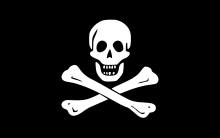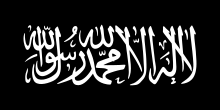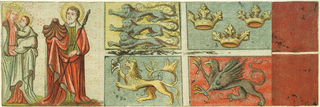This is a list of flags which are entirely or largely black.
This is a list of flags which are entirely or largely black.







In Ali Soufan's book The Black Banners, he explains the title by noting that quotes from various Hadiths regarding "Black Banners" of a "new army" taking over Khorasan have some kind of prophetic significance with many modern adherents of extremist jihadism. He notes that it is "not a coincidence" that Osama bin Laden made al-Qaeda's flag black. Soufan also notes that there is debate about whether the prophet Mohammed actually spoke some of the quoted Hadiths (such as one attributed to Abu Hurairah). He also notes that Sheikh Salman al-Ouda has said the Black Banner hadiths are not able to be authenticated. [4]



The black flag is a racing flag used to signal a driver's disqualification. In sail racing, when the black flag is displayed with the preparatory signal, a boat that is over the starting line in the minute before the starting signal is immediately disqualified without a hearing. In some forms of racing, a black flag is used to disqualify competitors or indicate some other penalty (such as a forced pit stop in NASCAR).
In The Silmarillion and other Middle-earth writings of J.R.R. Tolkien, the banner of the evil overlord Morgoth is described as being entirely black with no insignia. In The Lord of the Rings set several thousand years subsequently, the good Dúnedain bore a flag with solid black background as their royal standard, charged in silver with depictions of heirlooms from the founding of Gondor and Arnor including the Palantiri and the White Tree.

A flag is a piece of fabric with a distinctive design and colours. It is used as a symbol, a signalling device, or for decoration. The term flag is also used to refer to the graphic design employed, and flags have evolved into a general tool for rudimentary signalling and identification, especially in environments where communication is challenging. Many flags fall into groups of similar designs called flag families. The study of flags is known as "vexillology" from the Latin vexillum, meaning "flag" or "banner".

The national flag of Germany is a tricolour consisting of three equal horizontal bands displaying the national colours of Germany: black, red, and gold. The flag was first sighted in 1848 in the German Confederation. The flag was also used by the German Empire from 1848 to 1849. It was officially adopted as the national flag of the German Reich from 1919 to 1933, and has been in use since its reintroduction in Federal Republic of Germany in 1949.

The national flag of Poland consists of two horizontal stripes of equal width, the upper one white and the lower one red. The two colours are defined in the Polish constitution as the national colours. A variant of the flag with the national coat of arms in the middle of the white fess is legally reserved for official use abroad and at sea. A similar flag with the addition of a white eagle is used as the naval ensign of Poland.

Jolly Roger is the traditional English name for the naval ensign flown to identify a pirate ship preceding or during an attack, during the early 18th century. The vast majority of such flags flew the motif of a human skull, or “Death's Head”, often accompanied by other elements, on a black, dark brown or dark blue field, sometimes called the “Death's Head flag” or just the “black flag”.

In politics, a red flag is predominantly a symbol of left-wing politics, including socialism, communism, Marxism, labour movement, and anarchism. The originally empty or plain red flag has been associated with left-wing politics since the French Revolution (1789–1799).

White flags have had different meanings throughout history and depending on the locale.
A skull and crossbones is a symbol consisting of a human skull and two long bones crossed together under or behind the skull. The design originated in the Late Middle Ages as a symbol of death and especially as a memento mori on tombstones.

A maritime flag is a flag designated for use on ships, boats, and other watercraft. Naval flags are considered important at sea and the rules and regulations for the flying of flags are strictly enforced. The flag flown is related to the country of registration: so much so that the word "flag" is often used symbolically as a metonym for "country of registration".

Hazard symbols or warning symbols are recognisable symbols designed to warn about hazardous or dangerous materials, locations, or objects, including electromagnetic fields, electric currents; harsh, toxic or unstable chemicals ; and radioactivity. The use of hazard symbols is often regulated by law and directed by standards organizations. Hazard symbols may appear with different colors, backgrounds, borders, and supplemental information in order to specify the type of hazard and the level of threat. Warning symbols are used in many places in place of or in addition to written warnings as they are quickly recognized and more universally understood, as the same symbol can be recognized as having the same meaning to speakers of different languages.

Totenkopf is the German word for skull. The word is often used to denote a figurative, graphic or sculptural symbol, common in Western culture, consisting of the representation of a human skull- usually frontal, more rarely in profile with or without the mandible. In some cases, other human skeletal parts may be added, often including two crossed long bones (femurs) depicted below or behind the skull. The human skull is an internationally used symbol for death, the defiance of death, danger, or the dead, as well as piracy or toxicity.
Red flag may refer to:

Often called bloody flags or the bloody red, pattern-free red flags were the traditional nautical symbol in European waters prior to the invention of flag signal codes to signify an intention to give battle and that 'no quarter would be given', indicating that surrender would not be accepted and all prisoners killed, but also vice versa, meaning that the one flying the flag would fight to the last man. Such flags were traditionally plain but examples with motifs also existed, such as skull and crossbones on some pirate examples.

Emanuel Wynn was a French pirate of the 17th century who is often considered the first pirate to fly the Jolly Roger.

New England has no official flag. However, there have been many historical or modern banners used to represent the region in its history. While there are some variations, common designs include a plain colored field with a pine tree in the canton. The eastern white pine is the most common and prominent symbol of New England and is featured on many of the region's flags.
The skull and crossbones is a symbol of a human skull with two long bones crossed below it. It was historically used on the Jolly Roger pirate flag, and sees modern-day usage as a warning against poison or other deadly hazards.
Skull and crossbones variations have been used by several military forces. The "Jolly Roger", traditionally used by pirates, has been used by submarines.
The skull and crossbones was a common fraternal motif as a symbol of mortality and warning in the late nineteenth and early twentieth centuries. The symbol was adopted, for various reasons, by many sporting teams, clubs, and societies in both America and Europe.

The Jolly Roger is a symbol that has been used by submarines, primarily those of the Royal Navy Submarine Service and its predecessors. The practice came about during World War I: remembering comments by First Sea Lord Admiral Sir Arthur Wilson, who complained that submarines were "underhanded, unfair, and damned un-English" and that personnel should be hanged as pirates, Lieutenant Commander Max Horton began flying the flag after returning from successful patrols. Initially, Horton's submarine HMS E9 flew an additional flag after each successful patrol, but when there was no room for more, the practice was changed to a single large flag, onto which symbols indicating the submarine's achievements were sewn.

The flags of the Makhnovshchina consisted of a number of different black and red flags, each emblazoned with anarchist and socialist slogans.